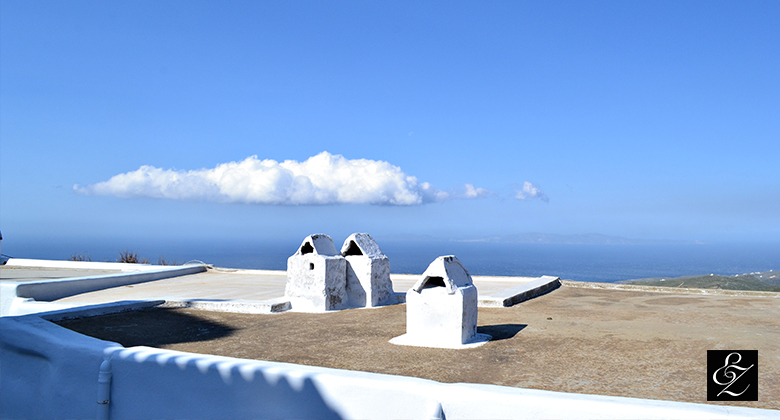
The island is famous for its Blessed Virgin and her miracles.
Tinos belongs to the islands of Cyclades. It is the island of the artists and the marble sculptors. Great Greek sculptors (Yannoulis Halepas, Demetrios Filippotis, Yannis Voulgaris, Lucas Dukas) and painters like Nikoforos Lytras, Nikolaos Gyzis came frome the island. It is not a coincidence at all that here are found the School of Fine Arts.
Tinos got its name from its first settler, leader of a team of Ionian people from Karia of Minor Asia. It is also said that it could be the name of a princess. The island was also called “Hydroussa” (“hydor” means “water” in Greek), due to the abundant waters and “Phidoussa” because of many snakes (“phidi” is “snake” in Greek).
On the island there are many churches, monasteries orthodox and catholic ones and more than 1000 country churches. The landmark of the island are the dovecotes, the two-floor buildings. These magnificent samples of folk art began to appear on the island during the Venetian period. Nowadays there are more than 600 dovecotes.
It is worth visiting:
√ The first stop is Chora, the capital and the port of the island. The holiest worship of Greece is found here; the Temple of the Evangelist Virgin of the Virgin of Tinos with the wonder icon. The Blessed Virgin of Tinos is indissolubly related to the history and the life of the island.
√ Ecclesiastical Heirloom and Icon Exhibition.
√ The Archeological Museum.
√ Ellis Mausoleum.
√ Portrait Gallery.
√ The Loutra village being once a religious and cultural centre. The landmark of the village is the Catholic monastery of Oursoulines, founded in 1862 by Maria-Anna Leeves. It was an orphanage, a boarding school, a French Gymnasium, a University, a Greek primary school, a carpet-making school. In the beginning of the 20thcentury it had more than 300 female students, daughters of rich families. There was also a theatre room, a drugstore of the school, musical rooms, sewing rooms. Pay a visit to the Folklore museum with a rich selection of relics of the Monastery, rural tools of the 19th and the 20th centuries, various means of audiovisual teaching, embroideries, old dresses, pianos, musical instruments, books of old students and others. In Loutra, one can find the Monastery of the Jesuits, as well.
√ The Holy Monastery of Virgin Mary or Kechrovouni. It was founded in the 10thor 11th century, today it hosts 50 nuns. One of them was Aghia Pelaghia, whose vision led to the finding of the wonder icon of the Blessed Virgin, which made the island known.
√ The Ysternia settlement with the beautiful marble square Glyni, the Museum of the Artists of Ysternia, the wind mills of the 19thcentury and the old churches.
√ The all green traditional settlement of Kardiani with its impressive architecture and the incredible view.
√ Pyrgos, of many great artists. Pay a visit to the house of the great Greek sculptor Yannoulis Halepas, the museum of the Artists of Tinos and the museum of marble-making. Make a tour to the beautiful settlement with the outstanding architecture, the churches, the elaborated decoration of Aghios Nikolaos and Aghios Demetrios, the School of Fine Arts, the numerous workshops of sculptures.
√ The Fish village Panormos with the taverns next to the sea surge.
√ The Volax village hidden among the round imposing granite rocks. In the village, visit the basket-making workshops; basket-making was the main activity of the villagers.
√ The Orthodox Monastery of Aghia Triada (the Holy Trinity) or Gyrlas, founded in the 11thcentury with the divine, wood-carved icon screen and the rare icons. In the Monastery is welcomed the Museum of Folklore Architecture of Tinos with a rare selection of marble infra-red sculptures.
Beaches:
Seek for the many beautiful beaches of the island:
√ Aghios Fokas, one of the biggest beaches of the island next to the mainland. Organized with sand and pine trees.
√ Kionia, a big pebbled beach combined with pine trees next to the antiquities. There are taverns and big hotels nearby.
√ Aghios Sostis, a famous cosmopolitan sandy beach.
√ Santa Margharita, a quiet, non-organized beach.
√ Aghios Ioannis (Porto), a frequented organized sandy beach with shallow waters.
Try:
√ The pork sausage tangs.
√ Tenian “louzes”.
√ The small fish with the famous spicy sweet-sour sauce “savouri”.
√ The fresh seafood.
√ The crumpets of sun-dried tomatoes.
√ The salads with beans and caper.
√ The local cheese “petroma” which means something petrified, “Stroggilo”, “Kopanisti”, “Malathouni”.
√ Sweet cheese-pies of Tinos. They're called "lichnarakia", "skepastes" or "tsimbites".




